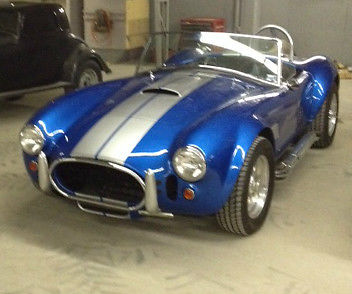some of you members may remember that my brother-in-law bought a cobra replica ,
well over the last few weeks he was complaining about an intermittent ignition miss, and the electrical cooling fans don,t seem to keep up full rpm,air flow, so he brought the car over to my shop and inside of about 10 minutes of testing , with a decent quality multi meter.
http://garage.grumpysperformance.com/index.php?threads/multi-meters.3110/#post-59136
http://garage.grumpysperformance.com/index.php?threads/how-altenators-work.355/#post-62266
http://garage.grumpysperformance.com/index.php?threads/battery-or-alternator.10003/#post-43220
http://garage.grumpysperformance.co...lem-getting-the-engine-started.63/#post-37970
http://garage.grumpysperformance.com/index.php?threads/chasing-a-crazy-electrical-glitch.986/
I found that the battery had only 12.2 volts and when the engine was running it never got to over 12.4 volts.
I ran a test on the alternator and its absolutely on its last legs and failing.
(in my B.I.L's. opinion)
(actually its failed completely ALREADY in my opinion )
I strongly suggested he, research, find, and buy and aftermarket 140 AMP-160 AMP replacement alternator we could install.
but my B.I.L. decided that researching that would be far to much effort,
so he bought a stock 75-90 amp alternator which ,at the local advance auto parts...
yes it cured the intermittent ignition issue , as it puts out a steady 13.6 volts once the engines spinning over 1200 rpm, and it gets to 14 volts by 2400 rpm, but hes missing out on a great deal of the alternators potential.
if he had simply purchased a 160 amp alternator I'm reasonably sure his cooling fans would run noticeably better, the battery would fully charge faster the starter would work better and the ignition would produce a better spark!
yes, the stock replacements cheaper and available the same day vs waiting two-to four days for the auto parts to arrive if ordered on-line, but at least too me the wait and expense would be well worth the minimal inconvenience!
after all the car would run noticeably better, rather than just returning it to basically functional

I don,t know why some people resist doing even minimal research
its not like it takes over 10 minutes to find several options
https://www.dbelectrical.com/alternators/automotive/ford/mustang/5-0-liter/
http://garage.grumpysperformance.com/index.php?threads/battery-or-alternator.10003/#post-43220
http://www.americanmuscle.com/paperformance-ho-alternator-8793.html
https://lmr.com/products/Mustang-200-AMP-Replacement-Alternators
https://www.summitracing.com/search...nators-and-generators/make/ford/model/mustang
well over the last few weeks he was complaining about an intermittent ignition miss, and the electrical cooling fans don,t seem to keep up full rpm,air flow, so he brought the car over to my shop and inside of about 10 minutes of testing , with a decent quality multi meter.
http://garage.grumpysperformance.com/index.php?threads/multi-meters.3110/#post-59136
http://garage.grumpysperformance.com/index.php?threads/how-altenators-work.355/#post-62266
http://garage.grumpysperformance.com/index.php?threads/battery-or-alternator.10003/#post-43220
http://garage.grumpysperformance.co...lem-getting-the-engine-started.63/#post-37970
http://garage.grumpysperformance.com/index.php?threads/chasing-a-crazy-electrical-glitch.986/
I found that the battery had only 12.2 volts and when the engine was running it never got to over 12.4 volts.
I ran a test on the alternator and its absolutely on its last legs and failing.
(in my B.I.L's. opinion)
(actually its failed completely ALREADY in my opinion )
I strongly suggested he, research, find, and buy and aftermarket 140 AMP-160 AMP replacement alternator we could install.
but my B.I.L. decided that researching that would be far to much effort,
so he bought a stock 75-90 amp alternator which ,at the local advance auto parts...
yes it cured the intermittent ignition issue , as it puts out a steady 13.6 volts once the engines spinning over 1200 rpm, and it gets to 14 volts by 2400 rpm, but hes missing out on a great deal of the alternators potential.
if he had simply purchased a 160 amp alternator I'm reasonably sure his cooling fans would run noticeably better, the battery would fully charge faster the starter would work better and the ignition would produce a better spark!
yes, the stock replacements cheaper and available the same day vs waiting two-to four days for the auto parts to arrive if ordered on-line, but at least too me the wait and expense would be well worth the minimal inconvenience!
after all the car would run noticeably better, rather than just returning it to basically functional

I don,t know why some people resist doing even minimal research
its not like it takes over 10 minutes to find several options
https://www.dbelectrical.com/alternators/automotive/ford/mustang/5-0-liter/
http://garage.grumpysperformance.com/index.php?threads/battery-or-alternator.10003/#post-43220
http://www.americanmuscle.com/paperformance-ho-alternator-8793.html
https://lmr.com/products/Mustang-200-AMP-Replacement-Alternators
https://www.summitracing.com/search...nators-and-generators/make/ford/model/mustang
Last edited:
